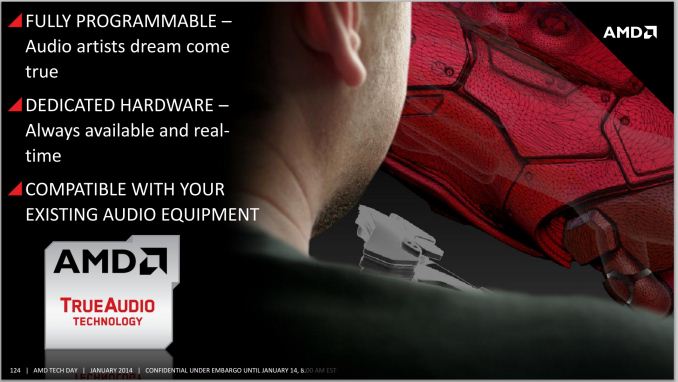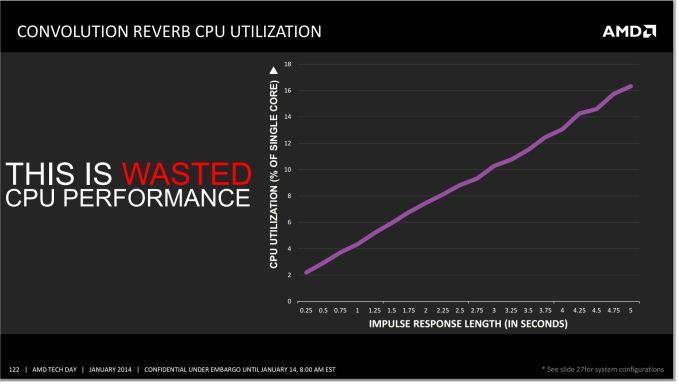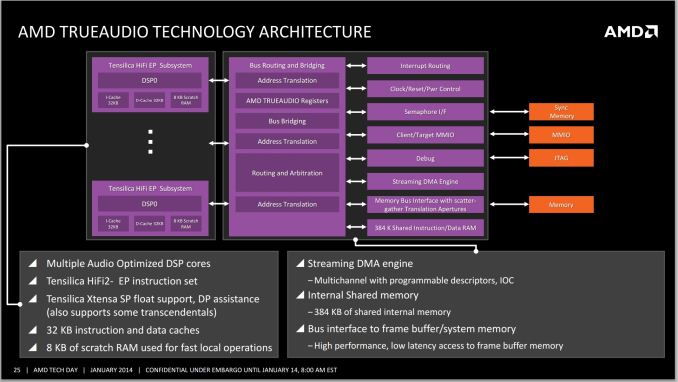AMD Kaveri Review: A8-7600 and A10-7850K Tested
by Ian Cutress & Rahul Garg on January 14, 2014 8:00 AM ESTTrueAudio
As part of the Kaveri package, AMD is also focusing on adding and updating their fixed function units / accelerators. Due to the jump on the GPU side to GCN we now have the TrueAudio DSP to allow developers to increase the audio capabilities in game, and both the Video Codec Engine (VCE) and Unified Video Decoder (UVD) have been updated.
All the major GPU manufacturers on the desktop side (AMD, NVIDIA, Intel) are pushing new technologies to help improve the experience of owning one of their products. There are clearly many ways to approach this – gaming, compute, content consumption, low power, high performance and so on. This is why we have seen feature like FreeSync, G-Sync, QuickSync, OpenCL adoption and the like become part of the fold in terms of these graphics solutions.
AMD’s new feature is TrueAudio - a fully programmable dedicated hardware element to offload audio tasks to.
The main problem with developing new tools comes down to whether they should be implemented in a general fashion or with a dedicated element. This comes down to the distinction of having a CPU or an ASIC do the work – if the type of work is specific and never changes, then an ASIC makes sense due to its small size, low power overhead and high throughput. A CPU wins out when the work is not clearly defined and it might change, so it opens up the realm of flexibility in exchange for performance per watt.
CPUs are now significantly powerful that a range of audio based techniques are available to them and the algorithms are optimized. The only limitation in this regard is the imagination of the developer or audio artist, which actually becomes part of the problem. When implementing an audio filter on the fly to a video game, the processing via the CPU can be overly taxing, especially when the effect is persistent over a long time. The example AMD gave in their press slide deck is one of adding reverb to an audio sample. The longer the reverb, the bigger the draw on CPU resources:
AMD cites this CPU usage as the effect of one filter on one audio sample. Imagine being in a firefight situation in a video game, whereby there are many people running around with multiple gunshots, splatter audio and explosions occurring. Implementing effects on all, and then transposing audio location to the position of the character is actually computationally expensive, all for the sake of realism. This is where the TrueAudio unit comes into play – the purpose is to offload all of this onto a dedicated bit of silicon that has the pathways built in for quicker calculations.
TrueAudio is also implemented on AMD's latest-generation R9 260 and R9 290 video cards – basically anything at least GCN 1.1 and up. Meanwhile we also know that the PS4’s audio DSP is based on TrueAudio, though given the insular nature of console development it's not clear whether the APIs are also the same on both platforms. AMD for their part is working with major audio middleware plugins (wwise, Bink) in order to help develop the TrueAudio ecosystem, so even in the case where the APIs are dissimilar, middleware developers can abstract that and focus on the similarities in the hardware underneath.
As is usually the case for these additional hardware features, games will need to specifically be coded to use TrueAudio, and as such the benefits of TrueAudio will be game specific. At the same time there are not any games currently on the market that can take advantage of the feature, so the hardware is arriving before there is software ready to use it. The first three games on AMD's list that will support TrueAudio are Murdered: Soul Suspect, Thief, and Lichdom. Much like FreeSync, I expect the proof is in the pudding and we will have to wait to see how it can affect the immersion factor of these titles.
Unified Video Decoder and Video Codec Engine
I wanted to include some talk about the UVD and VCE with Kaveri as both are updated – we get UVD 4, an update to error resiliency for H.264, and VCE 2, as shown below:
Of the two blocks, the improved VCE has the more interesting improvements to discuss. With the addition of support for B frames in H.264 encoding, the resulting ability to do backwards frame prediction should help improve the resulting image quality from VCE and/or reduce the required bitrates for any given quality level. Meanwhile the addition of support for the higher quality YUV444 color space in the H.264 encoder should help with the compression of primarily linear lineart/text, which in turn is important for the clarity of wireless displays.





















380 Comments
View All Comments
srkelley - Wednesday, January 15, 2014 - link
Some of us don't have a lot of money. It may be only $100 but it could mean giving up on buying games just to get a more powerful rig that can't play... games (that you would be willing to buy anyway). I'd like to buy/build a system that's great all around, I'd love to have the very best. The very best is overkill and some systems while not the best are still a bit too pricey.This APU will meet nearly all of my needs and exceed quite a few of them. I'm fine with not being able to max out my settings in every game, I'll be able to max most of them out at 1920x1080 @60 fps (or higher) with this apu. If the improvements in hybrid crossfire pan out (due to decreased latency and improvement in implementation) - I may be able to buy a super cheap gpu at a much later date to cover the rest of what I would need it for. I'll also be able to cool my system for a lower price (or just use stock everything).
Even if cf is a bust, the core product let's me spend a bit more on memory, better storage, a better case and even pick up a few new games without breaking my budget (if I sell my current monitor for asking price, I may be able to use it subsidize a slightly better one at the same time!). Right now I use a netbook, a smart phone and a pc that would struggle to play the original Assassin's Creed at 30fps with a 640x480 screen resolution. The monitor, speakers and wireless keyboard set is the only nice thing about my set-up. Time to step into the future - it's more than good enough for me and people like me.
Dribble - Thursday, January 16, 2014 - link
You can buy a cheaper non-apu cpu and discrete radeon graphics card for about the same amount and that would play games better and do everything else just as well, and still give you all the AMD advantages (mantle, etc). Would also give a better upgrade path as when in the future you are better off you can more easily upgrade cpu or graphics to something faster.The APU only really wins when you need it in a very small box too (so no room for discrete graphics)
Nagorak - Wednesday, January 15, 2014 - link
Well, I will say that one place that this may actually be worthwhile is in an HTPC with a tiny case that can't even take a half height graphics card. With anything that can take a half height graphics card it's moot.mikato - Wednesday, January 15, 2014 - link
But why do you need a discrete card with an HTPC? You don't.rpsgc - Tuesday, January 14, 2014 - link
No gaming benchmarks with dGPU? (I'm not talking about Dual Graphics.) Some people are interested on how this performs purely as a CPU, seeing as AM3 is apparently dead.YuLeven - Tuesday, January 14, 2014 - link
Well, it costs US$173. You can buy a Pentium G + Radeon HD7770GE for US$175~ on Newegg today. One set gives you all-in-one subpar 720p gaming, the other goes as up as 1080p in many titles. In fact, it's nearly cruelty comparing a HD7700GE to Kaveri's GPU.Well, unless you desperately need a one-chip solution, I see Kaveri as being utterly pointless as far gaming is concerned.
Ian Cutress - Tuesday, January 14, 2014 - link
It will be the focus of my next Gaming CPU article update; retesting over a dozen CPUs for this review, at 30 hours each, wasn't an easy task.YuLeven - Wednesday, January 15, 2014 - link
Super, Ian! I can't wait for it.srkelley - Wednesday, January 15, 2014 - link
Thanks for your hard work, you and Rahul did a great job! I always love reading the reviews at Anandtech. They're very informative, easy to read and leave me with a much, much better understanding of whatever they're covering when compared to how I went into it.Drumsticks - Tuesday, January 14, 2014 - link
Any chance you can make a summary of the 65 and 45W APUs vs an i3-4330 at 54W? That would be a more apt comparison especially considering the price range.